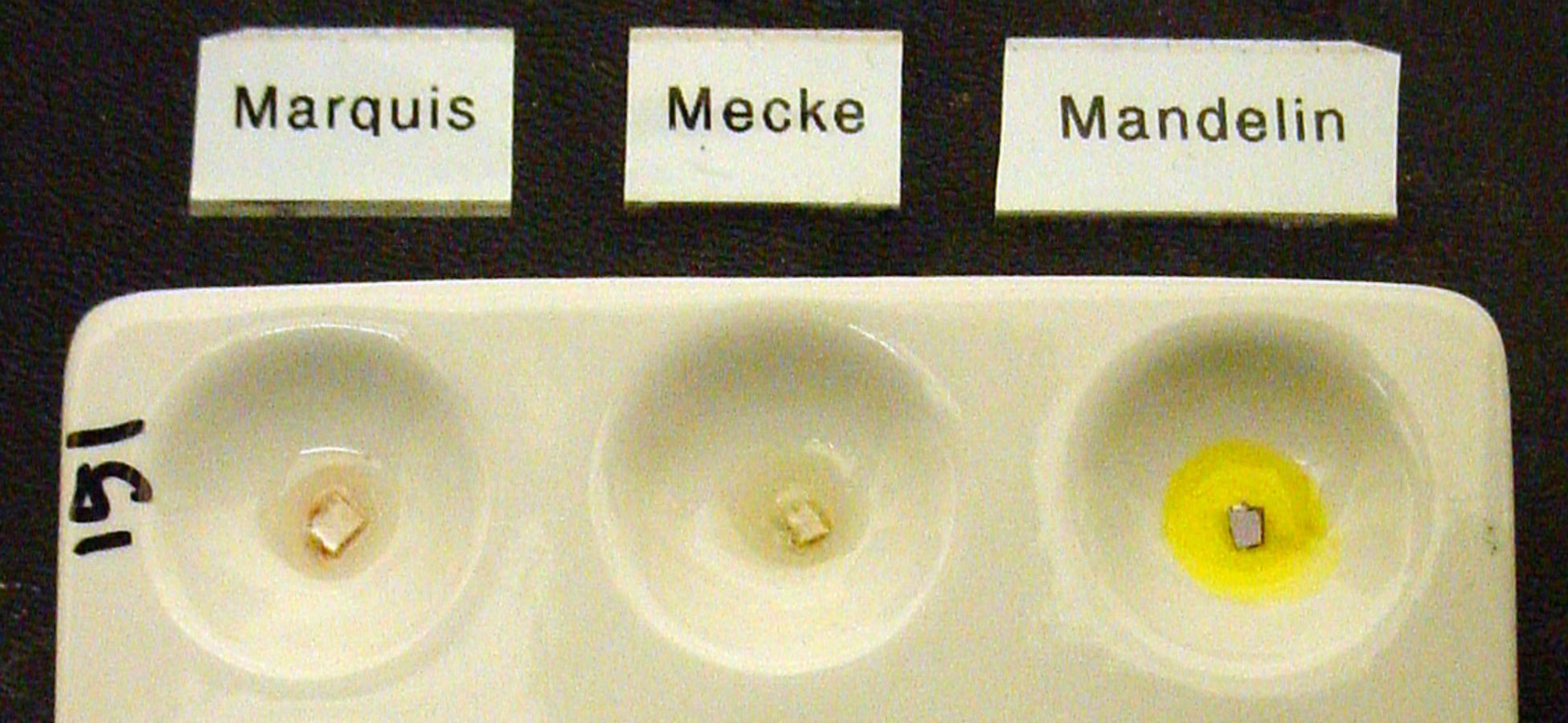Short Summary: Marquis, Mecke, Mandelin, and Simons are not reliable tools for confirming or disproving the presence of LSD in blotter, liquid, gel, or tablet forms.

Long Version: We get asked a lot about how specific drugs react to the various drug-detection field tests like Marquis, Mecke, Mandelin, Simons, Robadope, Ehrlich’s, etc. In most cases, it’s a matter of getting some of the pure target compound, a fresh set of reagents, and doing a little testing, photographing, and documentation..
However, with drugs active below 1mg, such as LSD, this may not be so simple. Because the amount of target compound is often very small, the reactions can be altered, slowed, or blocked by tiny amounts of other substances present. In the case of LSD blotter paper, where the amount of LSD on a 1/4″ square (6mmx6mm) is usually at or below 100 micrograms, the paper and the ink on the paper are far more likely to be the cause of a color change than the LSD itself. With liquid LSD, the alcohol carrier can dilute the response enough that no color change is visible. Thus, a color change or the lack of color change can be due to the form in which the substance is being tested.
LSD is said to create an olive green or black reaction with a Marquis reagent test. Organizations that sell reagent tests such as Dancesafe and Bunk Police report that LSD has an olive-black reaction with a Marquis test. This may be based upon sources such as this Department of Justice article stating that LSD causes an “Olive black” result. [ Fatah A. “Color Test Reagents/Kits for Preliminary Identification of Drugs of Abuse” (2000) ].

However, the results of our own lab’s field tests on samples confirmed to contain LSD using GC/MS show varying responses to Marquis and other field tests. When tested with a Marquis reagent, most of these samples showed no reaction or only a very slight reaction and none produced an olive green or black reaction. For examples of these test results see Figure 1 and Figure 2. Furthermore, the blotter paper itself—not the LSD—may be causing these slight reactions.
You can see a list of numerous LSD samples on EcstasyData along with their field test color changes here:
http://www.ecstasydata.org/results.php?start=0&search_field=substance&s=lsd&detail=true
Despite claims that LSD produces an olive green or black reaction to Marquis, evidence collected and published through EcstasyData does not support this. Furthermore, a 1979 paper by by Johns et al is consistent with these EcstasyData results. The researchers tested a wide variety of drugs from that era with nine different reagent tests, including Marquis and Ehrlich (Table 1). This paper reports that LSD only reacts with Ehrlich and not with any of the other reagents. Interestingly, the researchers used dry LSD from Sandoz Laboratories. Other publications claiming that LSD produces olive green or black reactions to Marquis do not report the source or form (i.e. liquid, crystal, or blotter) of the LSD tested. The results of the Johns et al., study suggests that confirmed pure crystal LSD has no reaction with a Marquis test. Below is a summary of the results:
| Compound | Reagent test | Color reaction | Testing surface |
|---|---|---|---|
| LSD | Marquis | no reaction | Porcelain |
| LSD | Mecke | no reaction | Porcelain |
| LSD | Madelin | no reaction | Porcelain |
| LSD | Cobalt thiocyanate | no reaction | Porcelain |
| LSD | Dille-Koppanyi | no reaction | Porcelain |
| LSD | Ehrlich | purple | Porcelain |
| LSD | Froehde | no reaction | Porcelain |
| LSD | Sulfuric acid | no reaction | Porcelain |
| LSD | Nitric acid | no reaction | Porcelain |
Although other sources say that LSD causes an olive-black reaction with a Marquis reagent test, this study, along with the EcstasyData results, suggests that LSD may not cause an olive-black reaction with a Marquis test—at least not on blotter paper in the amounts it is commonly sold. Based on this evidence, the Marquis is not a reliable for test for LSD. On the other hand, the Ehrlich may be an alternative test for this purpose based on the findings published by Johns et al. The Ehrlich reagent produces a color change when LSD or another indole is present. However, like all reagent tests, an Ehrlich is not a confirming test, it is just another in a wide array of rule in / rule out tests that can help confirm or deny the presence of LSD in a given sample.
Thanks to W and Shaolin at the DMT Nexus for their work on this issue.
